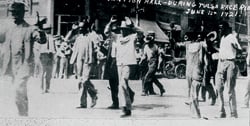May 31, 1921: Race riot erupts in Tulsa

AP Photo/Tulsa Historical Society
Before Memorial Day in 1921, Tulsa’s black community was a bustle of middle-class homeowners, business operators and professionals. Known as Greenwood, the thriving neighborhood was successful enough to include a thoroughfare nicknamed “the Black Wall Street.”
But as dusk developed on this particular day, the concern in Greenwood was news of a crowd of angry white men gathering at the county courthouse where black 19-year-old Dick Rowland, a shoe-shiner, was being held on charges that he had attempted to rape Sarah Page, 17, a white elevator operator. Fueled by holiday drinking and a small news item in the afternoon paper, the crowd was building itself into a lynch mob.
As tensions grew, a group of Greenwood residents, many of them veterans, arrived at the courthouse and volunteered to help protect the prisoner. Law enforcement officials rejected their offer but did little to disperse the mob. And by the time an even larger group of Greenwood volunteers returned—armed and determined—tensions burst: an angry confrontation, white upon black; a shot fired, perhaps by accident; shots returned. Several lay dead and wounded, both black and white.
Over the next two days, much of white Tulsa—convinced it was confronting a black rebellion—converged on Greenwood in a hate-filled fury of historic proportions. With something akin to military precision, homeowners were chased from their houses and shot, businesses sacked and burned, young men lynched. A machine gun loaded on a truck strafed Greenwood’s streets. Residents claimed that airplanes dropped turpentine incendiaries. Troops and law enforcement officers, sent to quell the riot, did little to protect Greenwood or its residents. In fact, many white rioters were deputized. Those not already armed were supplied guns and ammunition.
By the time it was over, as many as 300 were killed. More than 40 square blocks and 1,256 buildings—virtually every structure in the Greenwood district—were destroyed. And nearly every Greenwood resident was arrested and interned in makeshift holding centers. Greenwood was destroyed, but not one criminal act was ever prosecuted or punished at any level of government.
In September, four months after the riot, prosecutors received a letter from Page stating she did not want to press charges against Rowland. He was released from custody and left Tulsa for Kansas City.



